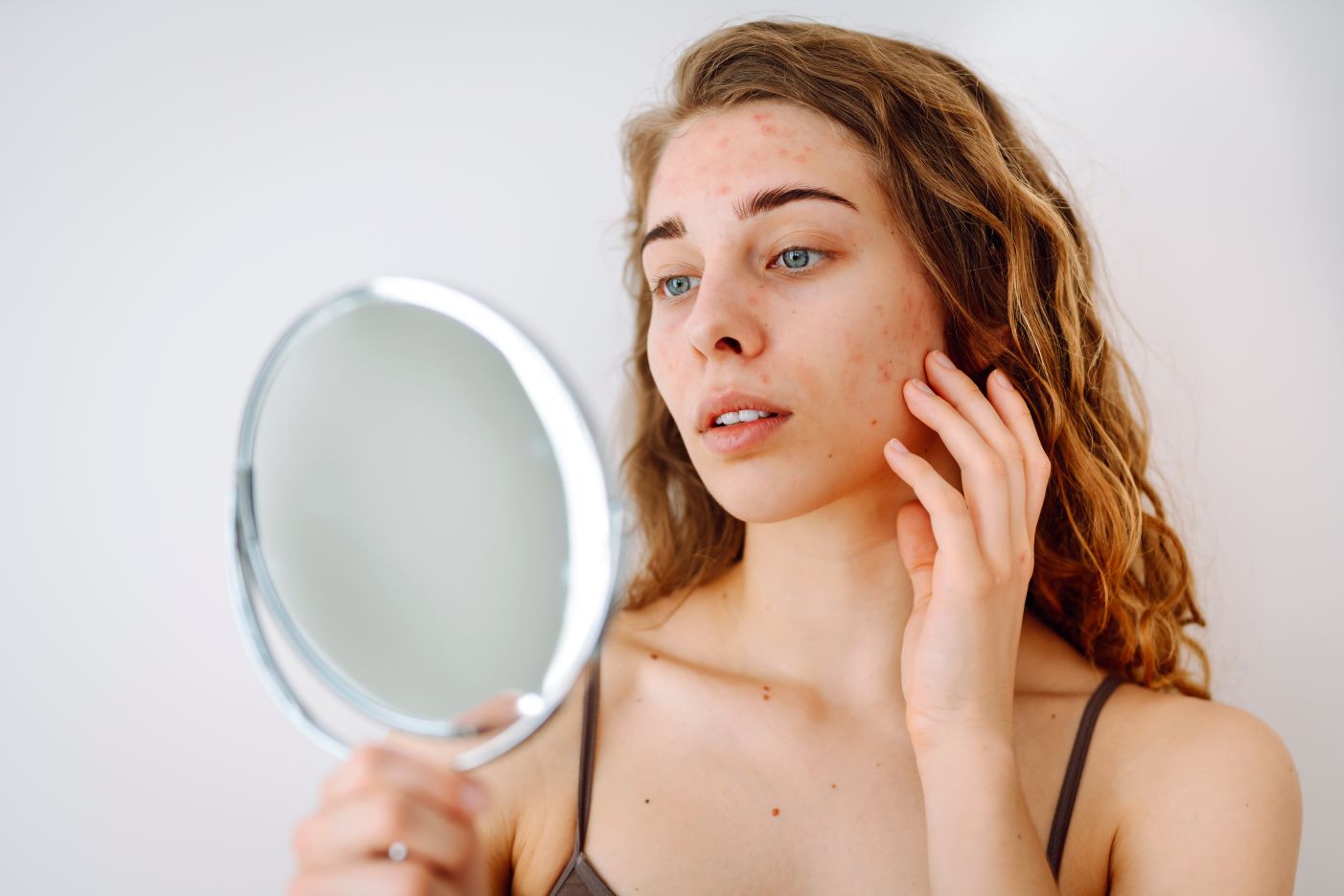Acne is the most common skin condition, impacting 50 million Americans each year, according to the American Academy of Dermatology. Because it’s so common, many people think they know what it is and can easily self-diagnose this condition. According to Dr. David Baltazar of U.S. Dermatology Partners in Peoria and Sun City West, Arizona, “Most people have struggled with acne symptoms or know someone who has. When lumps or bumps form on the skin, many assume the condition is acne, and they go to work trying to clear their skin with acne treatments. Unfortunately, numerous skin conditions share qualities with acne. Because these conditions require a different treatment approach, it’s important to receive an accurate diagnosis and develop a treatment plan with a dermatologist.” On this page, Dr. Baltazar breaks down some of the top skin conditions that mimic acne and gives differentiating characteristics of each.
Folliculitis: Not Your Typical Acne
Folliculitis is a skin condition that occurs when the hair follicle becomes inflamed due to an infection. Folliculitis may be caused by repetitive skin contact, tight-fitting or chaffing clothing, and shaving. Symptoms of folliculitis include:
- Bumps on the skin that resemble acne.
- Red rings around bumps that are a warning sign of infection.
- The area around the bumps is painful or irritated.
- Itchy skin around the bumps.
While folliculitis often looks and feels like an acne breakout, the underlying causes and treatments are very different. Specifically, acne is caused when pores become clogged due to the production of excessive levels of the body’s natural oils (sebum). This can cause dead skin cells, dirt, grime, and bacteria to be trapped in the pores, creating a pimple. While this clogged pore may trap bacteria and lead to infection, the infection is not the cause of acne, as is the case with folliculitis.
Keratosis Pilaris: Beyond Skin Bumps
Keratosis pilaris, often just called KP, is a benign skin condition that occurs when excessive levels of keratin build up on the surface of the skin. Keratin is a hard protein that protects the skin from harmful environmental elements. When an excessive amount of keratin develops and blocks the hair follicle, it causes rough, bumpy patches of skin. Unlike acne, which is associated with oily skin, KP develops on dry skin. The bumps won’t feel greasy or smooth. Instead, they feel dry and rough. Skin can be itchy or irritated. KP usually develops on the upper arms and legs. There is no cure for KP, but since this condition is harmless, treatment isn’t always needed. If dry or irritated skin becomes excessive or bothersome, some dermatologic treatments and skincare products can reduce the side effects of KP.
Rosacea: A Redder Side of Skin Concerns
Rosacea is an inflammatory skin condition best known for causing skin to appear red. The clinical name for this condition is acne rosacea, so it’s likely no surprise that these conditions may be mistaken for each other. Both acne rosacea and acne vulgaris (what most people simply call acne) are caused by swelling in the pores. In rosacea, the swelling doesn’t cause a blemish on top of the skin. Instead, it causes swelling beneath that skin that creates redness and swollen bumps or inflamed skin. Rosacea flare-ups can develop on the face over the nose and cheeks, but they can also impact the eyes. Clogged pores are not the cause of rosacea. Instead, the swelling and inflammation are caused by an autoimmune response that is triggered by certain environmental elements that differ from person to person. Managing rosacea involves learning individual triggers and limiting or avoiding exposure to these triggers. Skin impacted by rosacea may look red. It’s often very sensitive to touch and may sting or burn. The eyes may feel gritty, and vision may become less clear during flare-ups.
Syringoma: Small Bumps with a Difference
Syringoma is a non-cancerous growth that develops due to overactive sweat glands, causing abnormal tissue development in the sweat duct. Acne is connected to the overproduction of sebum. The overactive sweat glands in syringoma cause the development of small, firm bumps that may be yellow, pink, brown, or flesh-colored. They usually develop in small clusters on the neck, cheeks, and around the eyes, but they can form on any part of the body. One unique symptom, according to Dr. Baltazar, is that “Syringoma almost always develops symmetrically, so if you have a papule on the right side of your face, you’ll have one in the same spot on the left side. It’s one way that syringoma is significantly different from acne.”
Perioral Dermatitis: Around the Mouth Matters
Perioral dermatitis is, according to Dr. Baltazar, “Actually a skin rash. Perioral dermatitis can look like acne because it causes red, inflamed bumps. However, these bumps are usually concentrated only around the mouth, nose, and eyes. The swollen bumps, called papules, are usually painful to the touch, and they feel dry and scaly or may flake away. Skin may itch, burn, or sting. While this condition is similar in appearance to acne, the symptoms are much different, and the treatment for perioral dermatitis requires a unique approach developed with the help of a dermatologist.”
Staph Bacteria Infections: A Serious Mimicker
Staphylococcus (staph) bacteria commonly live on the skin’s surface, but when staph bacteria enter the skin through the pores or skin damage like cuts or burns, infection occurs. According to Dr. Baltazar, “While these skin infections often look like acne breakouts, it’s important to note that staph infection requires immediate professional treatment as it can spread or go deeper beneath the skin. Specifically, attempting to pop a bump that develops due to staph bacterial infection can cause the infection to spread across the skin, or it can push the infection deeper into the pores, leading to a severe infection that requires professional treatment.” The main difference between an acne pimple and a staph infection is the pain and inflammation, which occurs quickly and is much more pronounced compared with acne. Additionally, acne breakouts are most common on the face, chest, and back. Staph infections can occur anywhere on the body, but they are usually directly related to a cut, burn, scrape, cracked dry skin, or other place where there’s a gap in the skin’s protective outer layer.
Seeking Professional Diagnosis
According to Dr. Baltazar, “While acne is a common skin condition that many people believe they can accurately self-diagnose, there are numerous skin conditions outlined here that are often misdiagnosed as acne. In order to ensure you have the best treatment plan in place to maintain skin health, work with a dermatologist. They can recommend specific skincare products, dermatologic treatments, and preventive steps to keep skin looking and feeling its best.”
Knowing the Difference Means Seeking the Right Solution
In conclusion, Dr. Baltazar says, “It can be tempting to just let skin heal or use an over-the-counter acne treatment and hope for the best. For some, this may even work. However, it’s always best to rely on the professional guidance and recommendations of a dermatologist to ensure the skin condition you’re dealing with is, in fact, acne. When treated correctly, the symptoms of any of the skin conditions outlined here can be managed, but if you’re trying to treat acne, you’ll never clear flare-ups of these other skin conditions.”
Get Started Working with a Dermatologist
Unsure about your skin condition? Schedule a consultation with our dermatologists today for accurate diagnosis and effective treatment. To get started, take a few moments to complete our scheduling request form online. Once we hear from you, a local team member will reach out to finalize the details of your visit and answer any questions you may have.
Find a location near me
or


